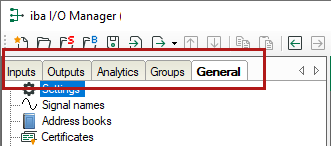"I/O" stands for "Input/Output". The I/O Manager is the main dialog for all configuration settings related to signals and interfaces.
All data sources and signals must first be defined in the I/O Manager. How the signals are then eventually used (display, recording, etc.) is subsequently determined in the other dialogs.
All setting options are clearly displayed in the I/O Manager. When configuring the input and output modules, the user is actively supported through context-sensitive selection menus. This helps to avoid configuration errors. Each change in configurations is checked by the system before being applied.
Note |
|
|---|---|
|
Changing the configuration settings in the I/O Manager always causes acquisition to automatically stop and restart! |
|
The I/O Manager can be accessed as follows:
-
Via the Configure - I/O Manager menu
-
Via the button

You will find four main sections in the I/O Manager where adjustments can make other settings:
-
Inputs
-
Outputs
-
Analytics
-
Groups
-
General

Due to the extent and scope, the description of the data interfaces, which are an integral part of the I/O Manager, is addressed separately in Data interfaces and modules.